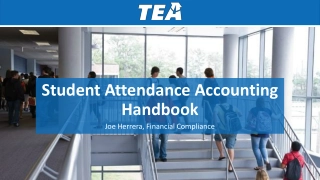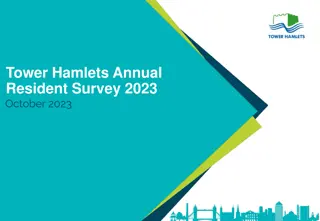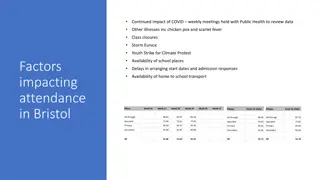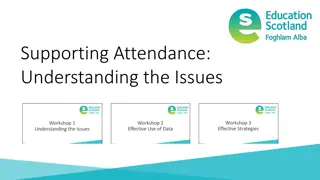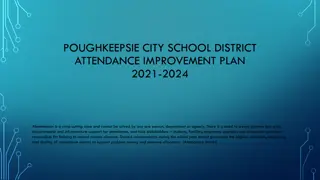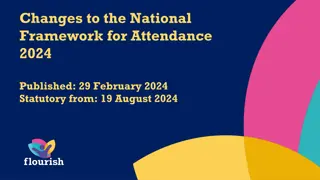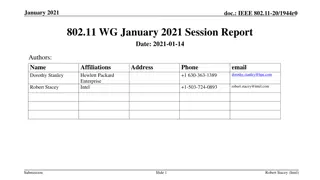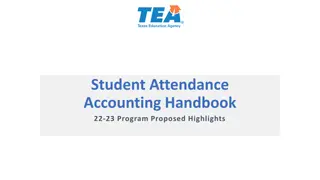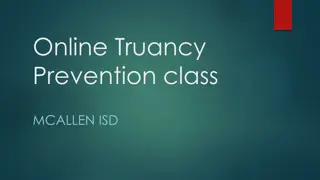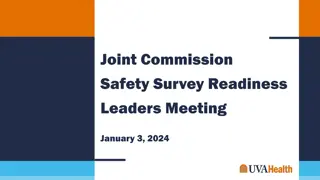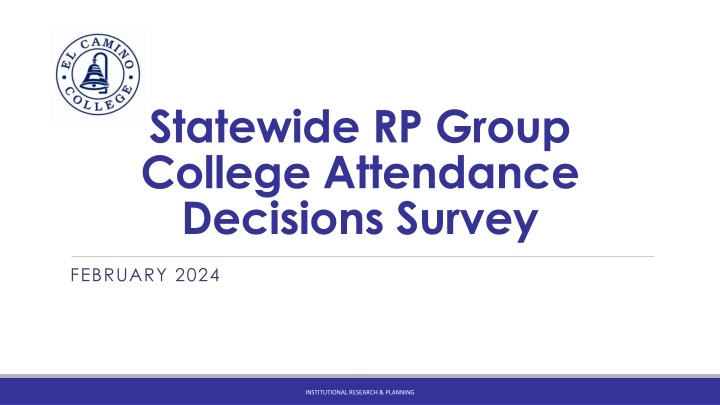
College Attendance Decisions: Survey Insights & Demographics
Gain valuable insights from a statewide RP Group survey on factors influencing California community college attendance decisions. Explore demographics of respondents and compare survey data with Fall 2023 student demographics to assess representation. Discover age groups and race/ethnicity details of previously enrolled and prospective students.
Uploaded on | 0 Views
Download Presentation

Please find below an Image/Link to download the presentation.
The content on the website is provided AS IS for your information and personal use only. It may not be sold, licensed, or shared on other websites without obtaining consent from the author. If you encounter any issues during the download, it is possible that the publisher has removed the file from their server.
You are allowed to download the files provided on this website for personal or commercial use, subject to the condition that they are used lawfully. All files are the property of their respective owners.
The content on the website is provided AS IS for your information and personal use only. It may not be sold, licensed, or shared on other websites without obtaining consent from the author.
E N D
Presentation Transcript
Statewide RP Group College Attendance Decisions Survey FEBRUARY 2024 INSTITUTIONAL RESEARCH & PLANNING
Statewide RP Group College Attendance Decisions Survey Summary Why: To understand factors influencing decisions of prospective and previously enrolled CC students to attend a California community college in Fall of 2023 and what they needed to attend college during this time. When: Administered in Fall 2023. This is a follow-up to the 2022 administration of the College Attendance Survey Response Rate: Students Contacted 21,777 1,360 23,137 Responded Response Rate 286 388 674 Previously Enrolled Prospective Total 1.3% 28.5% 2.9% INSTITUTIONAL RESEARCH & PLANNING
Characteristics of ECC Survey Respondents INSTITUTIONAL RESEARCH & PLANNING
What Was The Race/Ethnicity of ECC Respondents? Previously Enrolled Students Prospective Students Hispanic/Latinx 51% Hispanic/Latinx 36% White 18% African/African American/Black 18% 16% 15% 10% Asian 11% White Asian African/African American/Black 10% American Indian 1% Prefer not to answer American Indian Native Hawaiian/Pacific Islander 1% 1% 1% 1% 1% Middle Eastern/Arab/Arab American 1% Middle Eastern/Arab/Arab American Native Hawaiian/Pacific Islander Another description Another description 1% Prefer not to answer 5% INSTITUTIONAL RESEARCH & PLANNING
How Representative Were Survey Respondents Compared to Fall 2023 Student Race/Ethnicity Demographics? 45% Hispanic/Latinx Overrepresented African/African American/Black White 52% 17% White 14% 13% Asian Slightly overrepresented Native Hawaiian/Pacific Islander American Indian 14% 14% African/African American/Black 12% 1% Middle Eastern/Arab/Arab American Underrepresented Hispanic/Latinx 2% 1% Native Hawaiian/Pacific Islander 0% Slightly underrepresented Middle Eastern/Arab/Arab American Asian 1% American Indian 0% Survey Respondents Fall 2023 Student Race/Ethnicity Demographics INSTITUTIONAL RESEARCH & PLANNING
What Was The Age Groups of ECC Respondents? Previously Enrolled Students Prospective Students 71% 37% 22% 16% 14% 13% 9% 7% 5% 2% 2% 1% 18 to 24 25 to 34 35 to 49 50 to 64 65+ blank 18 to 24 25 to 34 35 to 49 50 to 64 65+ blank INSTITUTIONAL RESEARCH & PLANNING
How Representative Were Survey Respondents Compared to Fall 2023 Student Age Groups Demographics? 56% 18 to 24 Overrepresented 50 to 64 70% 14% 25 to 34 17% Slightly overrepresented 35 to 49 9% 8% 35 to 49 Underrepresented 18 to 24 25 to 34 5% 50 to 64 3% 1% 1% 65+ Adequately represented 65+ Survey Respondents Fall 2023 Student Age Group Demographics INSTITUTIONAL RESEARCH & PLANNING
Enrollment Plans FALL 2023 INSTITUTIONAL RESEARCH & PLANNING
OVERALL RESPONDENTS: Enrollment Plans 15% Enrollment plans of previously enrolled students improved compared to their enrollment last semester Enrolled full-time last semester 27% Plan to enroll at least half-time 13% Enrollment plans of prospective students show a preference for full-time enrollment 37% Plan to enroll full-time 70% 15% Currently enrolled in or considering at least one other CC Previously enrolled students are considering other enrollment options besides ECC more than prospective students 5% 16% 13% Currently enrolled at or considering a 4Y university Previously Enrolled Students Prospective Students INSTITUTIONAL RESEARCH & PLANNING
BLACK/AFRICAN-AMERICAN RESPONDENTS: Enrollment Plans 27% Enrolled full-time last semester Enrollment plans of Black/AA previously enrolled students improved compared to their enrollment last semester 29% Plan to enroll at least half-time 20% Enrollment plans of Black/AA prospective students show a preference for full-time enrollment Black/African American Previously Enrolled Students 33% Plan to enroll full-time Black/African American Prospective Students 73% Currently enrolled in or considering at least one other CC 18% Black/AA previously enrolled students are considering other CC besides ECC more than Black/AA prospective students 10% 14% Currently enrolled at or considering a 4Y university Black/AA prospective students are considering a 4- year institution more than Black/AA previously enrolled students 18% INSTITUTIONAL RESEARCH & PLANNING
HISPANIC/LATINX RESPONDENTS: Enrollment Plans Enrollment plans of LatinX previously enrolled students improved compared to their enrollment last semester 14% Enrolled full-time last semester 29% Enrollment plans of LatinX prospective students show a preference for full- time enrollment Plan to enroll at least half-time 13% 43% Plan to enroll full-time 77% 21% Currently enrolled in or considering at least one other CC LatinX previously enrolled students are considering other enrollment options besides ECC more than LatinX prospective students 6% 13% 12% Currently enrolled at or considering a 4Y university Hispanic/LatinX Previously Enrolled Students Hispanic/LatinX Prospective Students INSTITUTIONAL RESEARCH & PLANNING
Reasons Not to Enroll FALL 2023 INSTITUTIONAL RESEARCH & PLANNING
OVERALL RESPONDENTS: Top Reasons NOT to Enroll INSTITUTIONAL RESEARCH & PLANNING
BLACK/AFRICAN-AMERICAN RESPONDENTS: Top Reasons NOT to Enroll INSTITUTIONAL RESEARCH & PLANNING
HISPANIC/LATINX RESPONDENTS: Top Reasons NOT to Enroll INSTITUTIONAL RESEARCH & PLANNING
Reasons to Withdraw FALL 2023 INSTITUTIONAL RESEARCH & PLANNING
OVERALL RESPONDENTS: Reasons to Withdraw INSTITUTIONAL RESEARCH & PLANNING
BLACK/AFRICAN-AMERICAN RESPONDENTS: Reasons to Withdraw INSTITUTIONAL RESEARCH & PLANNING
HISPANIC/LATINX RESPONDENTS: Reasons to Withdraw INSTITUTIONAL RESEARCH & PLANNING
QUESTIONS TO ADDRESS Enrollment Plans & Full-Time Load Options Have we examined why previously enrolled students overall and Hispanic/Latinx previously enrolled students are considering other enrollment options besides ECC? As prospective students (overall, Black/African American and Hispanic/Latinx) show a preference for full-time enrollment, do we have program pathways options for students that can facilitate full-course loads? Work & Financial Aid As prioritizing work is a top reason not to enroll or to withdraw, are we working with local employers to help working students access job opportunities that are flexible and compatible with their academic schedules? Considering the inability to afford paying for college is a top reason not to enroll for Black/African American and Hispanic/Latinx students, do we have an inventory of the types of financial aid students can apply for? Are we regularly disseminating this inventory through different communication means? College Success As the inability to balance school with other responsibilities is a top reason not to enroll for Black/African American, are we offering workshops that teach time-management and prioritization skills? As the inability to keep up with college is a top reason to withdraw, have we examined how is the early alert system working? When and where are academic support services being offered? Can we engage challenged students to take a human development course (skills & knowledge needed to succeed in college)? Mental Health As mental health is a top reason to withdraw: Do we have an inventory of the health and wellness services we offer? Can we examine how we are disseminating the health and wellness services and with what frequency? How are we building a culture of empathy, understanding, and support? How can we get to the students who do not feel a sense of belonging? INSTITUTIONAL RESEARCH & PLANNING
Thank You EL CAMINO COLLEGE

